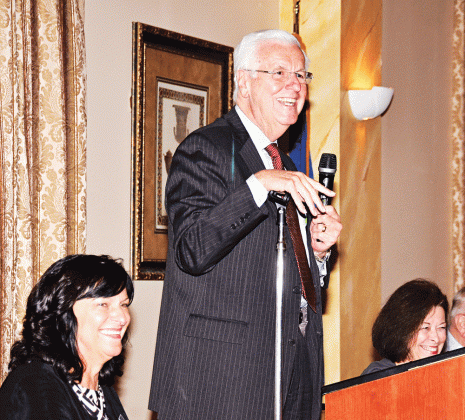
Zachary Fitzgerald
The next few months could be crucial to determine the future of how flood insurance operates in the United States, especially for south Louisiana, State Insurance Commissioner Jim Donelon said Wednesday.
Donelon was guest speaker during the St. Mary Chamber of Commerce business luncheon at the Petroleum Club of Morgan City.
He runs the state Department of Insurance, which is responsible for regulating Louisiana’s insurance industry.
Donelon discussed the National Flood Insurance Program. Coincidentally, the program was due to be reauthorized or renewed shortly after Hurricane Harvey and Hurricane Irma caused disastrous flooding.
Congress typically renews the program every five years, and the program was set to expire Sept. 30. Legislators recently passed a 90-day renewal of the program to give themselves “a little more time to do a long-term reauthorization,” Donelon said.
The federal government created the National Flood Insurance Program in 1968 after private insurers stopped covering flood damage for property owners following the destruction from Hurricane Betsy in 1965.
“A plethora of bills” have been put forth in Congress aimed at reforming the program, Donelon said.
Louisiana benefits from the program more than any other state. Since 1978, Louisiana has collected $19 billion in payments from the program. The next three most benefited states are Texas, New York and New Jersey, which have collected $6 billion apiece, Donelon said.
“It’s vital for us,” he said of the program.
There are four major components of the program legislators are working to address.
The first issue is determining what the cap on annual rate increases should be for policyholders who should be paying more for coverage based on the actuarial risk. However, they have been subsidized over the years through a grandfathering provision, Donelon said.
“That grandfathering is no doubt going to be continued. But the question is how much can your premiums go up each year until you reach actuarial costs,” he said.
The current cap on the annual rate is 18 percent. One proposed bill would lower that cap to 10 percent while another would drop the cap to 6 percent.
“Everybody in Louisiana would like it as low as possible. It’s what’s feasible, what can be accomplished,” he said.
A second issue is the authorization of the private insurers to compete with the federal government to offer flood insurance to consumers.
Private insurers technically are already allowed to provide flood insurance if they get approval from bank regulators who require flood insurance on properties located in flood-prone areas, he said.
But to allow the private sector to compete with the federal program, legislation needs to include “a bounce-back provision,” Donelon said.
That provision would mean that property owners, who were grandfathered in through the federal program at rates below what the actuarial risk showed and chose to enter the private insurance market, could get back into the National Flood Insurance Program if the private insurer decided to stop providing flood insurance.
If private insurers come back into the flood insurance market, about 70 percent of Louisiana’s 500,000 policyholders would receive “better coverage at a lower premium from the private sector,” he said.
“The MFIP would then be populated only with properties that are not adequately funded with their premium levels. What that would mean for the program going forward is very, very problematic,” Donelon said.
The third issue is the 60 day “proof of loss” period to file claims following a flood, he said.
“That ought to be extended,” Donelon said.
Federal officials issued an edict this week extending the “proof of loss” period for Harvey and Irma victims by a year.
“It ought to be made universal and apply to every flood policy,” he said.
A final positive major reform of the program would be to reauthorize the program for longer than the usual five-year time frame, Donelon said.
“There’s no reason why it can’t be done for six, eight or 10 years,” he said.
Following the devastating August 2016 flooding in the Baton Rouge and Lafayette areas, policyholders filed 30,000 claims resulting in $2.4 billion in payouts.
Those large payouts exacerbated the $25 billion deficit that the National Flood Insurance Program already had, Donelon said.
That deficit “will go through the roof in the aftermath of Florida and Texas flooding,” he said.
